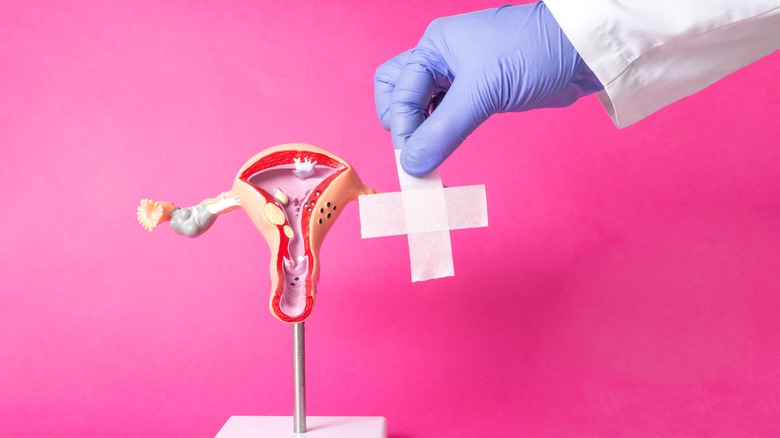Hailey Bieber Opens Up About Having Ovarian Cysts. It's More Common Than You Think
Hailey Bieber has come out with a statement negating rumors that she might be pregnant. Her statement makes it clear that instead of expecting, she actually has an apple-sized cyst on her ovary, reports CNN. This isn't the first time that the supermodel has experienced an ovarian cyst, as she said that she's had ovarian cysts before. In a social media post, Bieber wrote about her current cyst saying, "It's painful and achy and makes me feel nauseous and bloated and crampy and emotional." She ended the post by saying that she believes a lot of readers can relate to her experience.
In her statement, Bieber says that she doesn't have polycystic ovary syndrome or endometriosis, but she has had multiple ovarian cysts (via CNN). According to the National Health Service (NHS), ovarian cysts can be common, though often there may be no symptoms of a cyst's presence. There are several types of ovarian cysts that can develop in or on a woman's ovaries, the two small, almond-shaped sacs that are part of the female reproductive system. Even though many ovarian cysts go away on their own within a few weeks to months, knowing the symptoms of an intrusive ovarian cyst can be important because a ruptured cyst can lead to complications. Here's what you should know about this condition — that may be more common than you may realize.
Types of ovarian cysts
During monthly menstrual cycles, ovaries grow tiny cysts called follicles to emit progesterone and estrogen, the hormones needed to release an egg during ovulation, per Mayo Clinic. These small cysts are considered to be functional cysts. However, there are other types of ovarian cysts that can be intrusive and very painful. These include dermoid cysts, cystadenoma cysts, and endometrioma cysts. Dermoid cysts can also be referred to as teratoma cysts and are formed from reproductive cells, thus leading to cysts that can contain skin cells, pieces of teeth, and hair. While this may sound icky, the good news is that dermoid cysts are nearly always benign. Cystadenoma cysts tend to form on an ovary's surface and are created from the cells shed from the surface layers of the ovarian sac. Cystadenoma cysts are composed of liquid substances such as water, mucous, and other fluids. When referencing very large ovarian cysts, cystadenoma cysts are usually the culprit.
Endometrioma cysts are nicknamed chocolate cysts, though their name may be more appealing than their actual composition (via Cleveland Clinic). These cysts are formed with old menstrual blood and can be located anywhere within the ovary, or even in other parts of the reproductive system. Endometrioma cysts are often a sign of a condition called endometriosis, when endometrial tissue grows outside of the uterus. The World Health Organization (WHO) estimates that approximately 190 million women of reproductive age worldwide experience endometriosis, and are therefore at risk of developing endometrioma cysts.


